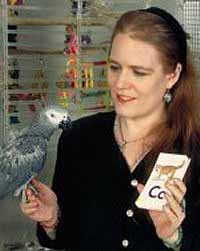THE N'KISI PROJECT
by Aimee
Morgana

The N'kisi Project is a series of controlled experiments and ongoing research in interspecies communication and telepathy conducted by Aimee Morgana and her language-using parrot N'kisi.
Interspecies Telepathy Experiments
N'kisi would often describe what Aimee was thinking about, reading, or
looking at in situations where there were no possible ordinary clues.
When Aimee saw Rupert Sheldrake's book Dogs That Know When Their Owners
Are Coming Home she contacted him, and they collaborated in designing
an experiment to try to replicate and document this phenomenon under controlled
conditions. Based on a pre-specified list of key words, a selection of
photographs depicting items from N'kisi's unedited vocabulary was prepared,
sealed in opaque envelopes, then randomized and numbered by an independent
party. No one knew what image was in any of the envelopes, which is known
as a "double blind" test. In a series of timed two minute sessions,
Aimee was videotaped as she looked at these images, while another synchronized
camera filmed N'kisi in his cage. Aimee was in an enclosed room on a different
floor, with no possible line of sight for any 'cueing'. Their locations
were approximately 55 feet apart, and separated by several solid walls.
In responding to the tests, N'kisi generally put target keywords and descriptions
in related sentences, and he often described a detail at the exact moment
that Aimee noticed it. N'kisi appears to telepathically "surf"
the leading edge of Aimee's consciousness, responding to the spontaneous
moment of discovery rather than to any consciously projected thoughts.
Aimee found that her state of mind was critical, and if she intentionally
tried to "send" the information, it wouldn't work. N'kisi responded
best when Aimee's full attention was genuinely immersed in exploring the
images, without any thought of the experiments. For example, in one image
of a car, the driver's head was sticking out of the car window. Just as
Aimee noticed this unusual detail, N'kisi said "Uh-oh, careful, you
put your head out.” Three independent transcripts were made of each
test session, and there was a remarkably good agreement between the transcribers.
These transcriptions were done "blind", meaning the transcribers
did not know what pictures Aimee was looking at, nor when each trial period
began and ended.
Analysis
and Scoring of Experiment Results
"Hits" and "misses" were scored when at least two
out of three transcribers verified that N'kisi had said one of the 19
key words used in selecting the images, such as "flower". N'kisi
said one or more of these key words in 71 trials, and the statistical
analysis is based on these tests. (We discarded several trials with the
target "camera", as N'kisi often made direct comments about
the cameras we were using). As an animal, N'kisi could not be expected
to fully understand the experiment parameters, and there was no guarantee
of his participation.
Conclusion:
As this study was strictly controlled against cues from any normal sensory
means, and chance coincidence has been ruled out, these experiments provide
compelling evidence of interspecies telepathy. This phenomenon is currently
unexplained within the dominant scientific model. We are continuing our
research and documentation of this astonishing phenomenon, as Aimee and
N'kisi's ongoing work exploring avian language use opens a fascinating
new window into our understanding of the animal mind. The fact that these
experiments statistically prove that N'kisi's use of speech is not random
also gives evidence of his sentience and intentional use of language.
Though our work is just beginning, N'kisi has already shown aspects of
intelligence that animals were thought to be incapable of, particularly
a species that shares so little genetic similarity with humans.

About
N’Kisi
N'kisi is a captive bred, hand raised Congo African Gray Parrot. He is
4-1/2 years old, and his species has a life span similar to humans. He
has received teaching in the use of language for 4 years. He is now one
of the world's top "language-using" animals, with an apparent
understanding and appropriate usage of over 700 words. Aimee intuitively
taught N'kisi as one would a child, by explaining things to him in context.
(This goes beyond typical interactions with a "pet", involving
many hours per day of teaching and conversations.) He is treated as a
member of the family. N'kisi was not trained like a performing animal,
and does not just mimic or use speech "on cue". Instead, he
has been allowed to develop his own creative relationship to language
as a means of self-expression. N'kisi speaks in sentences, showing a grasp
of grammar in formulating his own original expressions. He is capable
of actual conversations. He often initiates comments about what we are
doing, feeling, looking at, thinking, etc, which is how we discovered
his ability to read minds. N'kisi often demonstrates telepathy in spontaneous
situations, and also communicates love, compassion, and a keen sense of
humor.
About
Aimee Morgana
Since childhood, Aimee has had an intuitive connection with animals, and
used these insights in developing her own techniques for teaching parrots
to use language. Aimee has been working with parrots since 1985. Her goal
is to establish a true communicative dialogue with a member of another
species. Unlike laboratory researchers, Aimee decided to give N'kisi "dominance"
in their relationship, relinquishing control to open the door for his
creativity. She wanted to find out what a parrot might actually have to
say, which would reveal fascinating information about how these animals
think. Aimee's ongoing work with N'Kisi illustrates her concept of "partnership
research," an approach which honors and explores the close relationships
people can have with animals as friends and teachers. Aimee is part of
an emerging group of conceptually based artists interested in exploring
our human relationship with Nature in work dealing with animals, biology,
environmental concerns, and quantum aspects of consciousness. In a dynamic
cross-fertilization of approaches, some of these artists have begun collaborating
with scientists in new-paradigm research projects that bridge the disciplines
of Art and Science.
Excerpt from www.sheldrake.org/nkisi/, 2002